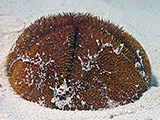Quentin Jossart PhD thesis
 Molecular ecology of a host-parasite relationship in an insular context: ectoparasitic crabs of spantagoid sea-urchins in the Caribbean Sea
Molecular ecology of a host-parasite relationship in an insular context: ectoparasitic crabs of spantagoid sea-urchins in the Caribbean Sea
Defended on the 30th September 2014
Supervisors: Chantal De Ridder (ULB) & Bruno David (uB)
Started in October 2011
Abstract
Comparing the population genetic structures of two species documents on the environmental factors and life history traits that shape the dispersal of the individuals. For host-parasite couple, this approach also permits to predict local adaptation of these species. The investigated species in this work are the ectoparasitic crab Dissodactylus primitivus and its sea urchin host Meoma ventricosa, both species being endemic to the Caribbean and neighboring American coasts. Several molecular markers were used, namely microsatellites and cytochrome oxidase I (mitochondrial). Moreover, morphometric analyses (shape) were also done.
By studying populations across the Caribbean arc and along the Panamanian coast, this work have shown that the genetic structure of the crab populations deeply differs from that of its host. Indeed, while the parasite populations are differentiated within this region, host populations are genetically homogeneous. This contrast can be explained by biological and ecological features (fecundity, swimming capacities, suitability of habitat) that are species specific and it suggests a distinct potentiality of local adaptation between host and parasite. Geographical distance seems to be a key parameter in the observed patterns but marine currents and historical events (glaciations) also play a role. At the local scale of a single island, crabs lack genetic and morphological differentiations when sites are compared along the coast. In addition, at the same scale (Jamaican lagoon), we demonstrated that crabs from different host species are not genetically differentiated. This lack of differentiation is at least partly explained by the mobility of adult crabs. Through paternity analyses, we underlined this mobility and we demonstrated that the crabs have a polygamous behavior but also that mating can occur among crabs from different host species.
- extrait:
- lien_externe:
- kc_data:
- a:8:{i:0;s:0:"";s:4:"mode";s:0:"";s:3:"css";s:0:"";s:9:"max_width";s:0:"";s:7:"classes";s:0:"";s:9:"thumbnail";s:0:"";s:9:"collapsed";s:0:"";s:9:"optimized";s:0:"";}
- kc_raw_content:
 Molecular ecology of a host-parasite relationship in an insular context: ectoparasitic crabs of spantagoid sea-urchins in the Caribbean Sea
Molecular ecology of a host-parasite relationship in an insular context: ectoparasitic crabs of spantagoid sea-urchins in the Caribbean SeaDefended on the 30th September 2014
Supervisors: Chantal De Ridder (ULB) & Bruno David (uB)
Started in October 2011
Abstract
Comparing the population genetic structures of two species documents on the environmental factors and life history traits that shape the dispersal of the individuals. For host-parasite couple, this approach also permits to predict local adaptation of these species. The investigated species in this work are the ectoparasitic crab Dissodactylus primitivus and its sea urchin host Meoma ventricosa, both species being endemic to the Caribbean and neighboring American coasts. Several molecular markers were used, namely microsatellites and cytochrome oxidase I (mitochondrial). Moreover, morphometric analyses (shape) were also done.
By studying populations across the Caribbean arc and along the Panamanian coast, this work have shown that the genetic structure of the crab populations deeply differs from that of its host. Indeed, while the parasite populations are differentiated within this region, host populations are genetically homogeneous. This contrast can be explained by biological and ecological features (fecundity, swimming capacities, suitability of habitat) that are species specific and it suggests a distinct potentiality of local adaptation between host and parasite. Geographical distance seems to be a key parameter in the observed patterns but marine currents and historical events (glaciations) also play a role. At the local scale of a single island, crabs lack genetic and morphological differentiations when sites are compared along the coast. In addition, at the same scale (Jamaican lagoon), we demonstrated that crabs from different host species are not genetically differentiated. This lack of differentiation is at least partly explained by the mobility of adult crabs. Through paternity analyses, we underlined this mobility and we demonstrated that the crabs have a polygamous behavior but also that mating can occur among crabs from different host species.
